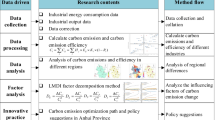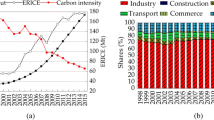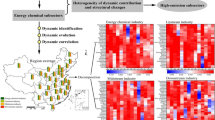Abstract
The primary problem in achieving carbon emission reduction and carbon peak is to identify the key driving factors and emission reduction potential of the industrial sector, especially in resource-cursed regions like Xinjiang. This study aimed to explore the key driving factors and abatement potential of carbon emissions based on the "energy-environment-economy" hybrid input–output model of Xinjiang during 1997–2017. The result showed that: (1) Industrial carbon emissions have experienced three stages: slow growth-rapid growth-stable growth. (2) Demand change effect and energy intensity effect were the determinants of Xinjiang industrial carbon emission change; Capital formation and domestic trade were the biggest drivers of carbon emissions growth; Especially after entering the "new normal",the driving force of imports in Xinjiang's international trade increased gradually over time. (3) The coal-based energy structure was both the biggest obstacle and the best entry point in carbon emission reduction. (4) Of the 28 key industry sectors, heavy industry including the production and supply of electricity and heat (S22), petroleum processing, coking and nuclear fuel processing (S11), chemical industry (S12), metal smelting and rolling (S14), and energy industries had the greatest potential for carbon reduction. The research findings provide scientific decision-making reference for Xinjiang to accurately grasp the carbon emission reduction potential of the industry and formulate a targeted carbon peak action plan.









Similar content being viewed by others
Data availability
Not applicable.
Notes
The new normal means that China's economy has entered a new stage different from the high-speed growth period of the past 30 years, which has three characteristics: in terms of speed, it has changed from high-speed growth to medium–high-speed growth; Structural aspect-the economic structure is constantly optimized and upgraded; Power-from factor-driven and investment-driven to innovation-driven (Zheng et al. 2019).
References
Cai H, Wang Z, Zhang Z, Xu X (2023) Carbon emission trading schemes induces technology transfer: evidence from China. Energy Policy 178:113595
Dietzenbacher E, Los B (1998) Structural decomposition techniques: sense and sensitivity. Econ Syst Res 10(4):307–324
Fan Y, Liu LC, Wu G, Tsai HT, Wei YM (2007) Changes in carbon intensity in China: empirical findings from 1980–2003. Ecol Econ 62(3–4):683–691
Fang K, Li C, Tang Y, He J, Song J (2022) China’s pathways to peak carbon emissions: new insights from various industrial sectors. Appl Energy 306:118039
Geng Y, Zhao H, Liu Z, Xue B, Fujita T, Xi F (2013) Exploring driving factors of energy-related CO2 emissions in Chinese provinces: a case of Liaoning. Energy Policy 60:820–826
Guan D, Hubacek K, Weber CL, Peters GP, Reiner DM (2008) The drivers of Chinese CO2 emissions from 1980 to 2030. Global Environ Chang 18(4):626–634
Guan Y, Shan Y, Huang Q, Chen H, Wang D, Hubacek K, (2021) Assessment to China's recent emission pattern shifts. Earth's Future 9(11):e2021EF002241
Li Q, Xue T (1998) Analysis of China's economic development sector: and new comparable input-output sequence list. China Statistics Press, 1997 edition. (in Chinese)
Li YL, Chen B, Han MY, Dunford M, Liu W, Li Z (2018) Tracking carbon transfers embodied in Chinese municipalities’ domestic and foreign trade. J Clean Prod 192:950–960
Li D, Huang G, Zhang G, Wang J (2020a) Driving factors of total carbon emissions from the construction industry in Jiangsu Province. China J Clean Prod 276:123179
Li L, Msaad H, Sun H, Tan MX, Lu Y, Lau AK (2020b) Green innovation and business sustainability: new evidence from energy intensive industry in China. Int J Environ Res Public Health 17(21):7826
Liang S, Zhang T (2011) What is driving CO2 emissions in a typical manufacturing center of South China? The case of Jiangsu Province. Energy Policy 39(11):7078–7083
Lin B, Wu W (2020) The implication of gobal energy efficiency evolution—SDA and empirial study based on global input-output data. Economic (Quarterly) 19(2):663–684 (in Chinese)
Liu Z, Adams M, Cote RP, Chen Q, Wu R, Wen Z, Dong L (2018) How does circular economy respond to greenhouse gas emissions reduction: an analysis of Chinese plastic recycling industries. Renew Sust Energy Rev 91:1162–1169
Miller RE, Blair PD (2009) Input-output analysis: foundations and extensions. Cambridge University Press
Peng Y, Shi C (2011) Determinants of carbon emissions growth in china: a structural decomposition analysis. Energy Procedia 5:169–175
Peters GP, Weber CL, Guan D, Hubacek K (2007) China's growing CO2 emissions a race between increasing consumption and efficiency gains
Shang Y, Lu S, Li X, Sun G, Shang L, Shi H, ... Wang H (2017) Drivers of industrial water use during 2003–2012 in Tianjin, China: a structural decomposition analysis. J Clean Prod 140:1136e1147
Su B, Ang BW (2012) Structural decomposition analysis applied to energy and emissions: some methodological developments. Ecol Econ 34(1):177–188
Su B, Ang BW (2015) Multiplicative decomposition of aggregate carbon intensity change using input-output analysis. Appl Energy 154:13–20
Tang K, Ma C (2022) The cost-effectiveness of agricultural greenhouse gas reduction under diverse carbon policies in China. China Agr Econ Rev, (ahead-of-print)
Tan Z, Li L, Wang J, Wang J (2011) Examining the driving forces for improving China’s CO2 emission intensity using the decomposing method. Appl Energy 88(12):4496–4504
Tang K, He C, Ma C et al (2019) Does carbon farming provide a cost-effective option to mitigate GHG emissions? Evidence from China. Aust J Agr Res Econ 63(3):575–592
Tang K, Wang M, Zhou D (2021a) Abatement potential and cost of agricultural greenhouse gases in Australian dryland farming system. Environ Sci Pollut Res 28:21862–21873
Tang K, Liu Y, Zhou D, Qiu Y (2021b) Urban carbon emission intensity under emission trading system in a developing economy: evidence from 273 Chinese cities. Environ Sci Pollut Res 28:5168–5179
Tang K, Chen Q, Tan W, Wu Feng YJ (2022) The impact of financial deepening on carbon reductions in China: Evidence from city-and enterprise-level data. Int J Environ Res Public Health 19(18):11355
Tian X, Chang M, Tanikawa H, Shi F, Imura H (2013) Structural decomposition analysis of the carbonization process in Beijing: a regional explanation of rapid increasing carbon dioxide emission in China. Energy Policy 53:279–286
Wang Y, Zhao H, Li L, Liu Z, Liang S (2013) Carbon dioxide emission drivers for a typical metropolis using input-output structural decomposition analysis. Energy Policy 58:312–318
Wang X, Teng F, Zhou S, Cai B (2017a) Identifying the industrial sectors at risk of carbon leakage in China. Clim Policy 17(4):443–457
Wang H, Zhang Y, Zhao H, Lu X, Zhang Y, Zhu W, ... McElroy MB (2017b) Trade-driven relocation of air pollution and health impacts in China. Nat Commun 8(1):1–7
Wang C, Zhang X, Zhang H, Wang F (2017c) Influencing mechanism of energy-related carbon emissions in Xinjiang based on IO-SDA model. Acta Geogr Sin 3:365–384
Wang Z, Yang Y, Wang B (2018) Carbon footprints and embodied CO2 transfers among provinces in China. Rene Sustain Energy Rev 82:1068–1078
Wang M, Wang P, Wu L et al (2022) Criteria for assessing carbon emissions peaks at provincial level in China. Adv Clim Chang Res 13(1):131–137
Wei J, Huang K, Yang S, Li Y, Hu T, Zhang Y (2017) Driving forces analysis of energy-related carbon dioxide (CO2) emissions in Beijing: an inputâ output structural decomposition analysis. J Clean Prod 163:58–68
Wu J, Feng Z, Tang K (2021) The dynamics and drivers of environmental performance in Chinese cities: a decomposition analysis. Environ Sci Pollut Res 28:30626–30641
Xiu J, Zang X, Piao Z, Li L, Kim K (2023) China’s low-carbon economic growth: an empirical analysis based on the combination of parametric and nonparametric methods. Environ Sci Pollut Res 30(13):37219–37232
Xu M, Li R, Crittenden JC, Chen Y (2011) CO2 emissions embodied in China’s exports from 2002 to 2008: a structural decomposition analysis. Energy Policy 39(11):7381–7388
Xu H, Zhao G, Xie R, Zhu K (2020) A trade-related CO2 emissions and its composition: evidence from China. J Environ Manage 270:110893
Yan Q, Wang Y, Baležentis T, Streimikiene D (2019) Analysis of China’s regional thermal electricity generation and CO2 emissions: decomposition based on the generalized Divisia index. Sci Total Environ 682:737–755
Yang L, Li Z (2017) Technology advance and the carbon dioxide emission in China-Empirical research based on the rebound effect. Energy Policy 101:150–161
Yang L, Yang Y, Zhang X et al (2018) Whether China’s industrial sectors make efforts to reduce CO2 emissions from production?-A decomposed decoupling analysis. Energy 160:796–809
Yang J, Song D, Fang D, Wu F (2019) Drivers of consumption-based PM2. 5 emissions of Beijing: a structural decomposition analysis. J Clean Prod 219:734–742
Yan M, Sun H, Gu K (2022) Driving factors and key emission reduction paths of Xinjiang industries carbon emissions of Xinjiang industries: an industry chain perspective. J Clean Prod 374:133879
Yu Y, Tang K (2023) Does financial inclusion improve energy efficiency? Technol Forecast Soc Chang 186:122110
Zhang Y (2009) Structural decomposition analysis of sources of decarbonizing economic development in China; 1992–2006. Ecol Econ 68(8–9):2399–2405
Zhang Z, Yu Y, Wang D, Kharrazi A, Ren H, Zhou W, Ma T (2021) Socio-economic drivers of rising CO2 emissions at the sectoral and sub-regional levels in the Yangtze River Economic Belt. J Environ Manage 290:112617
Zhao X, Ding X, Li L (2021) Research on environmental regulation, technological innovation and green transformation of manufacturing industry in the Yangtze River Economic Belt. Sustainability 13(18):10005
Zheng J, Mi Z, Coffman DM, Milcheva S, Shan Y, Guan D, Wang S (2019) Regional development and carbon emissions in China. Energy Econ 81:25–36
Zhou X, Zhou D, Wang Q, Su B (2020) Who shapes China’s carbon intensity and how? A demand-side decomposition analysis. Ecol Econ 85:104600
Zhou J, Zhang Z, Xu X, Chang D (2022) Does the transformation of resource-dependent cities promote the realization of the carbon-peaking goal? An analysis based on typical resource-dependent city clusters in China. J Clean Prod 365:132731
Zhu X, Li R, (2017) An analysis of decoupling and influencing factors of carbon emissions from the transportation sector in the Beijing-Tianjin-Hebei Area, China. Sustainability 9(5):722
Zhu B, Su B, Li Y, Ng TS (2020) Embodied energy and intensity in China’s (normal and processing) exports and their driving forces, 2005–2015. Energy Econ 91:104911
Acknowledgements
This paper is supported by Guangdong Major Project of Basic and Applied Basic Research (2020B0301030004), The Natural Science Foundation of China (71963030).
Author information
Authors and Affiliations
Contributions
Kuiying Gu initiated the study. Kuiying Gu, Min Yan and Pengyue Dou performed the statistical analysis. Kuiying Gu drafted the paper. Kuiying Gu, Min Yan, Pengyue Dou and Liang Zhao revised the paper. All authors read the final version of the manuscript and approved the submission.
Corresponding author
Ethics declarations
Ethics approval
Not applicable.
Consent to participate
Not applicable.
Consent for publication
Not applicable.
Conflict of interest
The authors declare no competing interests.
Additional information
Responsible Editor: V.V.S.S. Sarma
Publisher's note
Springer Nature remains neutral with regard to jurisdictional claims in published maps and institutional affiliations.
Appendix
Appendix
Table 2
Table 3
Table 4
Table 5
Table 6
Table 7
Rights and permissions
Springer Nature or its licensor (e.g. a society or other partner) holds exclusive rights to this article under a publishing agreement with the author(s) or other rightsholder(s); author self-archiving of the accepted manuscript version of this article is solely governed by the terms of such publishing agreement and applicable law.
About this article
Cite this article
Gu, K., Yan, M., Dou, P. et al. Who drives carbon emissions and what emission reduction potential in the resource curse agglomeration: a case of Xinjiang. Environ Sci Pollut Res 30, 100403–100430 (2023). https://doi.org/10.1007/s11356-023-29247-5
Received:
Accepted:
Published:
Issue Date:
DOI: https://doi.org/10.1007/s11356-023-29247-5




